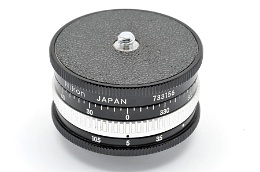

This head disassembles and also folds to make it easier to transport. The 303SPH is a superbly engineered head and although it does look complicated, it’s really quite quick and simple to set up once you get used to it. I used the Manfrotto 303SPH on a set of 058B legs for the header photo on this article which shows Harringworth viaduct, the longest masonry viaduct in Britain. Panoramic heads vary from the simple and quick to set up types to the extreme precision and rather complicated looking ones. I have used the 393 with the Manfrotto 190 Tripod and have found this setup a good and stable mount for my Canon 1D Mk1v and 500mm f/4 L IS lens and it has rewarded me with many wildlife images in low light situations where I wouldn’t have been able to get as sharp and well tracked shots without such a stable system. The dual tension adjustment knobs clamp up to a 600mm lens and camera setup very well and with a panning friction base, the photographer is able to pan and follow subjects with ease.

It does, however, work extremely well on a sturdy tripod and that is where you will find most people using this system.īuilt to a very high quality and with rubber hand grips, perfect for working the mount in all weathers, the 393 Gimbal head comes complete with a quick release plate which locks in place to prevent accidental movement. The Manfrotto 393 heavy telephoto lens support was produced as an ideal support for long lenses on a Monopod. Whilst I’ve tried them, I haven’t used these extensively-so I asked my friend, wildlife photographer Stuart Shore, why he uses one. These specialised tripod heads are really intended for photographers using big, heavy and unwieldy long lenses. Sometimes I use a video head for a specialist still photo- an upwards pan during a slow exposure for instance like this one.
Panorama video head tv#
Watch a TV interview where the cameraman hasn’t used a tripod and if it goes on for any length of time you will see exactly what I mean!

As a result if I’m doing an interview I much prefer to work from the stable platform of the tripod and fluid head. The longer you hold the camera by hand, the more shake becomes a problem too with video, (and stills for that matter). Remember the longer the lens, the more chance of shake and I’d almost always use the tripod with its fluid head or a monopod to support my camera for shots on a lens longer than 100mm. I need the versatility to quickly get the video camera off the tripod for hand-held following shots, etc. A quick release on these tripod heads is pretty much a necessity when I shoot with them. You can vary the friction so that it’s easier to achieve very slow pans with it damped right down, or backed off for a faster whip pan. Try one and you will immediately see how much easier they are for getting really smooth pans and camera movements. Whilst I sometimes use a video fluid head for stills, these and the fluid-effect heads are really meant for video use.

Manfrotto’s latest designs completely eliminate the old problem of play in the ball joints resulting in ‘operating drift’. It can cope extremely well with most types of shoot and I’ve reviewed that particular head elsewhere on this site here.īall heads are in lightweight magnesium and are very easy to use and quickly lock the camera into position. Manfrotto make the X-Pro ball head which is one of the most compact types of head available. You don’t know which tripod head to choose? A great tripod head to start with is something like my favourite- a tripod ball head. It’s a facility I personally wouldn’t want to be without as there is nothing worse for me than the time wasted unscrewing a camera from a tripod and then having to laboriously re-thread it on again later. These use a plate locking device to firmly hold the camera in place or at the touch of a button and/or a lever, release it fast for hand holding the camera or switching to another lens or camera. Another consideration for which tripod head to buy if whether to go for one with a QR or quick release system.


 0 kommentar(er)
0 kommentar(er)
